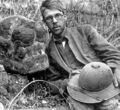Template:Selected anniversaries/September 3: Difference between revisions
No edit summary |
No edit summary |
||
| Line 7: | Line 7: | ||
||1710 – Abraham Trembley, Swiss biologist and zoologist (d. 1784) Father of Biology | ||1710 – Abraham Trembley, Swiss biologist and zoologist (d. 1784) Father of Biology | ||
File:James Joseph Sylvester.jpg|link=James Joseph Sylvester (nonfiction)|1814: Mathematician and academic [[James Joseph Sylvester (nonfiction)|James Joseph Sylvester]] born. He will make fundamental contributions to matrix theory, invariant theory, number theory, partition theory, and combinatorics. | |||
File:Sylvanus Morley.jpg|link=Sylvanus Morley (nonfiction)|1916: Archaeologist and crime-fighter [[Sylvanus Morley (nonfiction)|Sylvanus Morley]] uses archaeological expedition to Mexico during World War I as cover story for secret investigation into alleged Maya-related [[crimes against mathematical constants]]. | File:Sylvanus Morley.jpg|link=Sylvanus Morley (nonfiction)|1916: Archaeologist and crime-fighter [[Sylvanus Morley (nonfiction)|Sylvanus Morley]] uses archaeological expedition to Mexico during World War I as cover story for secret investigation into alleged Maya-related [[crimes against mathematical constants]]. | ||
||1925 – USS Shenandoah, the United States' first American-built rigid airship, was destroyed in a squall line over Noble County, Ohio. Fourteen of her 42-man crew perished, including her commander, Zachary Lansdowne. | |||
File:Philo T Farnsworth.jpg|link=Philo Farnsworth (nonfiction)|1928: Inventor [[Philo Farnsworth (nonfiction)|Philo Farnsworth]] demonstrates his electronic television system to the press. | File:Philo T Farnsworth.jpg|link=Philo Farnsworth (nonfiction)|1928: Inventor [[Philo Farnsworth (nonfiction)|Philo Farnsworth]] demonstrates his electronic television system to the press. | ||
| Line 23: | Line 17: | ||
File:Cantor Parabola.jpg|link=Cantor Parabola|1929: Math photographer [[Cantor Parabola]] takes retro-temporal pictures of inventor [[Philo Farnsworth (nonfiction)|Philo Farnsworth]] demonstrating his electronic television system, revealing unexpected correspondences with other timelines. | File:Cantor Parabola.jpg|link=Cantor Parabola|1929: Math photographer [[Cantor Parabola]] takes retro-temporal pictures of inventor [[Philo Farnsworth (nonfiction)|Philo Farnsworth]] demonstrating his electronic television system, revealing unexpected correspondences with other timelines. | ||
|File: | ||1954 – The German submarine U-505 begins its move from a specially constructed dock to its site at Chicago's Museum of Science and Industry. | ||
File:Viking orbiter.jpg|link=Viking 2 (nonfiction)|1976: Viking program: The [[Viking 2 (nonfiction)|Viking 2]] spacecraft lands at Utopia Planitia on Mars. | |||
</gallery> | </gallery> | ||
Revision as of 10:08, 5 August 2017
1658: Oliver Cromwell dies. He was a military and political leader and later Lord Protector of the Commonwealth of England, Scotland, and Ireland.
1814: Mathematician and academic James Joseph Sylvester born. He will make fundamental contributions to matrix theory, invariant theory, number theory, partition theory, and combinatorics.
1916: Archaeologist and crime-fighter Sylvanus Morley uses archaeological expedition to Mexico during World War I as cover story for secret investigation into alleged Maya-related crimes against mathematical constants.
1928: Inventor Philo Farnsworth demonstrates his electronic television system to the press.
1929: Math photographer Cantor Parabola takes retro-temporal pictures of inventor Philo Farnsworth demonstrating his electronic television system, revealing unexpected correspondences with other timelines.
1976: Viking program: The Viking 2 spacecraft lands at Utopia Planitia on Mars.





